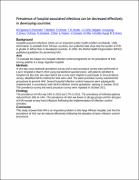| dc.contributor.author | Ogwang, David Martin | |
| dc.contributor.author | Paramatti, D. | |
| dc.contributor.author | Molteni, T. | |
| dc.contributor.author | Ochola, E. | |
| dc.contributor.author | Okello, Tom Richard | |
| dc.contributor.author | Salgado, J.C.Ortiz | |
| dc.contributor.author | Kayanja, A. | |
| dc.contributor.author | Greco, C. | |
| dc.contributor.author | Kizza, D. | |
| dc.contributor.author | Gondoni, E. | |
| dc.contributor.author | Okot, J. | |
| dc.contributor.author | Praticò, L. | |
| dc.contributor.author | Granata, V. | |
| dc.contributor.author | Filia, H. | |
| dc.contributor.author | Ayugi, H.Kellar | |
| dc.contributor.author | Greco, D. | |
| dc.date.accessioned | 2021-05-23T12:10:13Z | |
| dc.date.available | 2021-05-23T12:10:13Z | |
| dc.date.issued | 2013 | |
| dc.identifier.citation | Ogwang, M., Paramatti, D., Molteni, T., Ochola, E., Okello, T. R., Salgado, J. O., ... & Greco, D. (2013). Prevalence of hospital-associated infections can be decreased effectively in developing countries. Journal of Hospital Infection, 84(2), 138-142. | en_US |
| dc.identifier.issn | https://doi.org/10.1016/j.jhin.2013.02.016 | |
| dc.identifier.uri | https://www.sciencedirect.com/science/article/abs/pii/S0195670113001072 | |
| dc.identifier.uri | https://hdl.handle.net/123456789/266 | |
| dc.description.abstract | Background
Hospital-acquired infections (HAI) are an important public health problem worldwide. Little information is available from African countries, but published data show that the burden of HAI is greater in Africa than in developed countries. In 2002, the World Health Organization (WHO) published guidelines for preventing HAI.
Aim
To evaluate the impact of a hospital infection control programme on the prevalence of HAI among patients in a large Ugandan hospital.
Methods
A one-day cross-sectional prevalence survey and a ward procedure survey were performed in Lacor Hospital in March 2010 using standardized questionnaires. All patients admitted to hospital not less than two days before the survey were eligible to participate in the prevalence survey. Modified WHO criteria for HAI were used. The ward procedure survey examined the procedures to prevent HAI. Several hospital infection control measures were subsequently implemented, in accordance with WHO infection control guidelines, starting in October 2010. The prevalence survey and ward procedure survey were repeated in October 2011.
Findings
The prevalence of HAI was 34% in 2010 and 17% in 2011. The prevalence of infected patients reduced from 28% to 14%. The prevalence of HAI was lower in all age groups and for all types of HAI except urinary tract infections following the implementation of infection control activities.
Conclusion
This study showed that HAI is an important problem in this large African hospital, and that the prevalence of HAI can be reduced effectively following the adoption of basic infection control procedures. | en_US |
| dc.language.iso | en | en_US |
| dc.publisher | Journal of Hospital Infection | en_US |
| dc.subject | Hospital-acquired infections | en_US |
| dc.subject | Prevalence | en_US |
| dc.subject | Prevention | en_US |
| dc.subject | Africa | en_US |
| dc.title | Prevalence of hospital-associated infections can be decreased effectively in developing countries | en_US |
| dc.type | Article | en_US |

